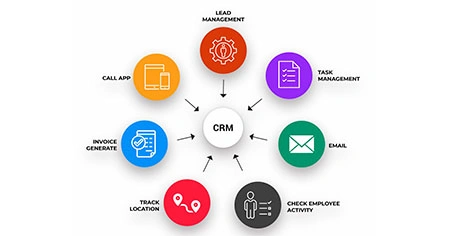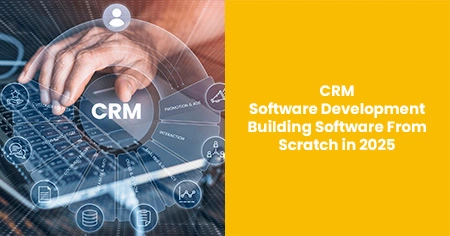CRM software is vital in improving customer connections and optimizing business procedures. The capacity to handle client interactions and understand their requirements is critical.
Salesforce reported that CRM solutions may enhance sales productivity by 34% and revenue by 29%. This demonstrates how CRM may improve corporate efficiency and revenue growth.
With the CRM market estimated to reach over $80 billion in revenues by 2025, investing in custom CRM development will help your business grow.
Organizations must maintain strong customer relationships in an increasingly competitive market, making a well-designed CRM system a crucial tool. Whether you're managing a locker management system or a large-scale customer database, a robust CRM can streamline operations.
But how can you build a CRM solution that the company needs? To learn more, let's examine the step-by-step CRM software development process from scratch.
What is CRM Software?

CRM software is designed to manage a company's contacts with existing and potential consumers. It integrates various services to make collecting, storing, and analyzing customer information easier, boosting customer interactions and simplifying company processes. CRM systems like Microsoft Dynamics CRM improve business operations by automating and coordinating sales, marketing, customer service, and technical support.
How is Building Software From Scratch in 2025?

Building Customer Relationship Management (CRM), software is a major endeavour that demands careful preparation and a thorough grasp of your software development company's needs and goals.
Let's investigate each step in the preliminary planning process to ensure your journey toward bespoke CRM development is strategic and aligned with your business goals.
Step 1: Planning
The first and most important step in developing a custom CRM is to define and communicate your business objectives precisely. These objectives range from improving customer service to increasing sales and improving internal communication and operational efficiencies. It's critical to thoroughly study your software development company operations, customer relationship difficulties, and objectives for your CRM system.
Step 2: Identify business goals
Defining these goals not only directs the development process but also aids in measuring the success of your CRM once it is implemented. Setting SMART goals can help refine your objectives, making them more actionable and reachable.
Step 3: Conduct market research and analysis
After you've defined your goals, you must research the market to see what's currently available and how your CRM development can stand out. This step focuses on learning from the successes and pitfalls of existing CRM systems and identifying innovation potential.
Look at prominent CRM solutions used by firms in your industry. Evaluate their features, cost, user interface, and customer feedback using reliable product feedback tools. What makes these CRMs successful, and where do they fall short? For example, if consumers frequently complain about a problematic interface, you might concentrate on developing a more intuitive design for your CRM.
Stay current with the newest CRM trends and technologies. For instance, are there any new automation tools that help improve customer interaction? Understanding current trends enables you to implement cutting-edge features that keep your Elite software development competitive.
Step 4: Explore types of CRM systems
Defining these goals not only directs the development process but also aids in measuring the success of your CRM once it is implemented. Setting SMART goals can help refine your objectives, making them more actionable and reachable.
Operational CRMs are designed to manage everyday sales, marketing, and customer service operations. They streamline workflows and customer interactions, making managing leads, sales processes, and customer engagements easier.
Analytical CRMs collect, analyze, and leverage customer data. They are helpful for firms seeking to understand customer behaviour, segmentation, and personalization tactics.
Collaborative CRMs prioritize communication and collaboration between internal teams and customers. They help share client information between departments, increase service performance, and provide a consistent approach to customer management.
Step 5: Design a user-centric interface
Your CRM's design is similar to your system's front entrance; it should be welcoming, simple to use, and functional. A user-centric design guarantees that everyone, from your sales team to customer support, can use the CRM effectively and without feeling overwhelmed. A simple interface may encourage people to embrace CRM. Aim for simplicity by arranging features logically and reducing unneeded clutter. Consider: What tasks will users complete most frequently, and how can we streamline these processes?
Step 6: Set access levels
It's critical to prioritize these features according to your specific requirements and budget. Striking the correct balance between must-have features and those that are good but not immediately necessary ensures that your CRM is successful and cost-efficient.
Data security and integrity are crucial in CRM development. To protect critical customer and business data, you must determine who has access to which information within your CRM. This includes setting user roles and permissions that determine access levels for various team members and ensuring data is handled securely and in accordance with data protection requirements.
Step 7: Choose the right technology stack
Choosing the right technology stack is critical in the CRM development process. This stack defines the tools, programming languages, and frameworks that will form the backbone of your CRM development. Correctly choosing guarantees that your system is scalable, efficient, and maintainable.
Step 8: Create a budget
relationship based access control (ReBAC) can help you manage these permissions more efficiently, improving security and operational functionality.
A thorough budget is required for developing a custom CRM, which includes everything from early planning and design to implementation, testing, and maintenance. It is critical to evaluate the initial and continuing expenditures, such as software license (if required), development resources, hardware, and third-party services or integrations. A thorough budget helps to avoid unforeseen costs and guarantees that the project is financially viable throughout its existence.
Step 9: Develop core CRM features
With your technology stack in place, it's time to focus on designing your CRM's primary functionality.
These features are the heart of your system, built to achieve the goals you set in Step 2.
Step 10: Test and iterate
Testing is essential for CRM development to ensure seamless functionality and match user expectations. Tests should be considered a quality assurance method for identifying and resolving any issues before the CRM goes live.
Step 11: Launch and beta testing
The launch stage introduces the program to the beta phase, addresses issues, and prioritizes user feedback.
Step 12: Deployment and maintenance
Once your CRM has passed all its tests, it's time to implement it. Deployment entails making the CRM available to your staff and ensuring everything works smoothly. But the journey does not end there—ongoing maintenance is essential for long-term success.








